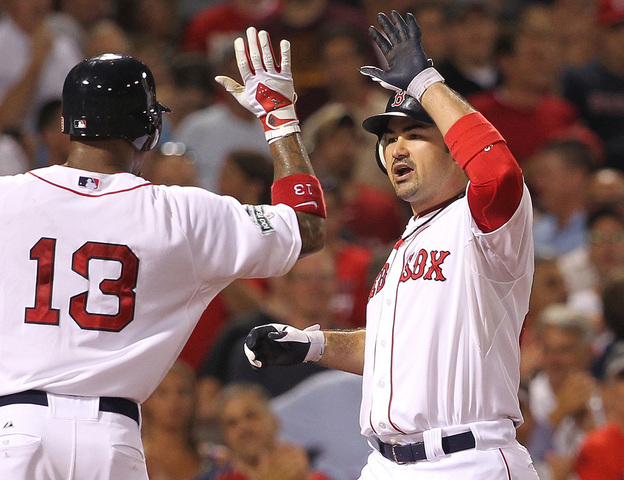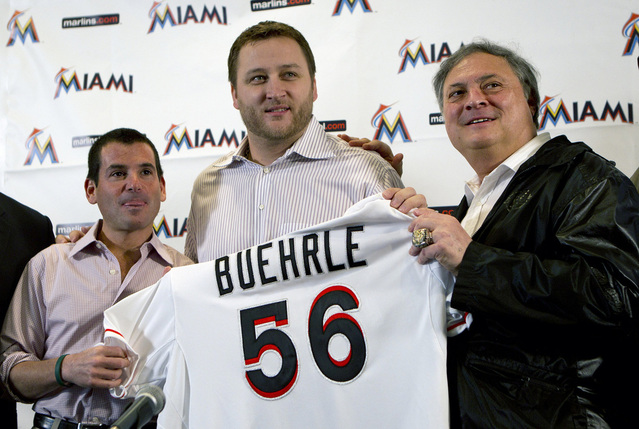The Changing Financial Landscape of MLB: Analyzing Trades by the Red Sox and Marlins
Published By Steven Tydings (Columnist), Edited by Daniel Lewis (Editor-in-Chief) on November 18, 2012 in The Penn Sport Report. Click to read article in The Penn Sport Report.
 Jim Rogash/Getty Images
Jim Rogash/Getty Images
On August 25, 2012, Major League Baseball changed forever. The only problem is that hardly anyone realized it.
At the time, the Boston Red Sox were in the midst of a horrible stretch of baseball. They had lost 87 of their last 152 games dating back to September 1, 2011 and were well on their way to another disappointing season. Their team had mutinied against the manager, and team’s brass had a number of large contracts that were undermining their budget.
Meanwhile, the Los Angeles Dodgers were slowly making their way back to relevancy. The team had finally come out from under the abysmal ownership of Frank McCourt and had been sold for $2 billion, a record amount for a professional sports team. Furthermore, they continued to battle for the pennant with their bitter rivals, the San Francisco Giants.
These factors led to one of the most important trades in MLB history. The Red Sox traded Adrian Gonzalez, Josh Beckett, Carl Crawford, and Nick Punto for James Loney and four prospects from the Dodgers. While the deal may have seemed like an ordinary blockbuster, it was, due to one large factor: money.
The Red Sox had not only dealt three large name players in Gonzalez, Beckett, and Crawford, but had unloaded the large contracts that went with it. Boston had given up over $260 million in contracts to the Dodgers without paying any of the remaining salaries. There was no deal like this before. It was a trend-setter.
This deal was made possible by the fact that MLB is the only major professional sports league without a salary cap. Furthermore, unlike the NFL, all contracts are guaranteed. A major advantage is given to the larger market teams, who can spend more money and take advantage of free agency because they bring in more money.
Around the turn of the century, more and more teams have begun to sign players to contracts at increasingly exorbitant prices. Teams have become burdened by these large contracts, such as the Texas Rangers’ $252 million agreement with Alex Rodriguez in 2001. Although the Rangers were able to deal Rodriguez’s contract as the Red Sox did a decade later, they still had to pay $67 million of the remaining contract three years later.
Returning to the Adrian Gonzalez trade, the Red Sox were able to get out of three of their large contracts--without paying a single dollar. The Dodgers were more than willing to absorb the contracts, despite the fact that they also gave up multiple their top prospects.
In its 2011 Collective Bargaining Agreement, the NBA added an amnesty clause that allowed teams to remove one of their contracts from the cap records without any ramifications. The Red Sox were able to receive the same salary relief, but they did not need a lockout to achieve it, as teams in the NBA did.
This trade sets the trend for future teams to get out of contract obligations. When management hands out a contract that goes bad, there is now clear precedent on how a team can get out of their dumber decisions without any of the costs. With more teams like the Dodgers getting richer owners and television deals, teams are able to absorb contracts and let the smaller market or less financially savvy teams out of their mistakes.
At the time, the Boston Red Sox were in the midst of a horrible stretch of baseball. They had lost 87 of their last 152 games dating back to September 1, 2011 and were well on their way to another disappointing season. Their team had mutinied against the manager, and team’s brass had a number of large contracts that were undermining their budget.
Meanwhile, the Los Angeles Dodgers were slowly making their way back to relevancy. The team had finally come out from under the abysmal ownership of Frank McCourt and had been sold for $2 billion, a record amount for a professional sports team. Furthermore, they continued to battle for the pennant with their bitter rivals, the San Francisco Giants.
These factors led to one of the most important trades in MLB history. The Red Sox traded Adrian Gonzalez, Josh Beckett, Carl Crawford, and Nick Punto for James Loney and four prospects from the Dodgers. While the deal may have seemed like an ordinary blockbuster, it was, due to one large factor: money.
The Red Sox had not only dealt three large name players in Gonzalez, Beckett, and Crawford, but had unloaded the large contracts that went with it. Boston had given up over $260 million in contracts to the Dodgers without paying any of the remaining salaries. There was no deal like this before. It was a trend-setter.
This deal was made possible by the fact that MLB is the only major professional sports league without a salary cap. Furthermore, unlike the NFL, all contracts are guaranteed. A major advantage is given to the larger market teams, who can spend more money and take advantage of free agency because they bring in more money.
Around the turn of the century, more and more teams have begun to sign players to contracts at increasingly exorbitant prices. Teams have become burdened by these large contracts, such as the Texas Rangers’ $252 million agreement with Alex Rodriguez in 2001. Although the Rangers were able to deal Rodriguez’s contract as the Red Sox did a decade later, they still had to pay $67 million of the remaining contract three years later.
Returning to the Adrian Gonzalez trade, the Red Sox were able to get out of three of their large contracts--without paying a single dollar. The Dodgers were more than willing to absorb the contracts, despite the fact that they also gave up multiple their top prospects.
In its 2011 Collective Bargaining Agreement, the NBA added an amnesty clause that allowed teams to remove one of their contracts from the cap records without any ramifications. The Red Sox were able to receive the same salary relief, but they did not need a lockout to achieve it, as teams in the NBA did.
This trade sets the trend for future teams to get out of contract obligations. When management hands out a contract that goes bad, there is now clear precedent on how a team can get out of their dumber decisions without any of the costs. With more teams like the Dodgers getting richer owners and television deals, teams are able to absorb contracts and let the smaller market or less financially savvy teams out of their mistakes.
 J. Pat Carter/The Associated Press
J. Pat Carter/The Associated Press
On November 17, the Marlins were able to take advantage of this new financial precedent. After spending over $100 million just an offseason ago, the Marlins were able to relief themselves of all their large contracts by trading over $160 million in remaining obligations to the Blue Jays in the form of Jose Reyes, Mark Buehrle, and Josh Johnson.
The Marlins have been known for selling off their players the year after winning championships. However, this time, they made the deal after finishing well below .500 and a year after opening their new stadium. The Marlins had been criticized for their contracts they handed out in the 2011 offseason, but now they were able to completely circumvent their financial commitments while still receiving taxpayer money to pay for their new stadium.
In the past, the New York Yankees have always been the poster child for reckless spending in MLB. Now, the Dodgers, Red Sox, and Marlins are displaying how a team can make poor financial decisions and avoid dealing with any consequences.
It is only a matter of time before teams give out similarly awful contracts, and the Dodgers and Yankees are waiting to bail out these teams.
Growing up, we are taught that bad things happen to people who do bad things. However, on August 25, 2012, the Dodgers and Red Sox displayed that you can get large rewards for foolish contracts, and this new precedent has changed MLB in the process.
The Marlins have been known for selling off their players the year after winning championships. However, this time, they made the deal after finishing well below .500 and a year after opening their new stadium. The Marlins had been criticized for their contracts they handed out in the 2011 offseason, but now they were able to completely circumvent their financial commitments while still receiving taxpayer money to pay for their new stadium.
In the past, the New York Yankees have always been the poster child for reckless spending in MLB. Now, the Dodgers, Red Sox, and Marlins are displaying how a team can make poor financial decisions and avoid dealing with any consequences.
It is only a matter of time before teams give out similarly awful contracts, and the Dodgers and Yankees are waiting to bail out these teams.
Growing up, we are taught that bad things happen to people who do bad things. However, on August 25, 2012, the Dodgers and Red Sox displayed that you can get large rewards for foolish contracts, and this new precedent has changed MLB in the process.